As Paramaribo, Suriname, flooded with shin-high water during a rainstorm in June, hundreds of taxis jostled for space on a recently paved street on the outskirts of the capital city. Passengers in suits disembarked alongside an overgrown canal. The visitors, some of whom had come from as far away as Texas and Malaysia, were there to commemorate this small country’s entry into the ranks of the world’s major oil producers.
Paramaribo sits on the northeast coast of South America, at the edge of a relatively undisturbed section of the Amazon rainforest. This massive jungle covers more than 90 percent of Suriname’s landmass, making it the world’s most forested country by percentage. It also allows Suriname to claim itself as “carbon-negative,” meaning that the nation absorbs more greenhouse gases than it emits.

As a result, Suriname is one of the few countries that can make an unimpeachable claim to being on the right side of the climate crisis. But all that is about to change. In 2028, the country’s first offshore oil platform will begin pumping almost a quarter-million barrels of crude each day, roughly enough to supply the daily needs of all the drivers in the state of Colorado. In its first year alone, this project from the French oil major TotalEnergies is expected to generate billions of dollars of revenue for the government and billions more in private spending, causing the country’s economy to grow by more than half. More offshore rigs are expected to follow.
The air at the fifth annual Suriname Energy, Oil, and Gas Summit in June buzzed in anticipation of this coming prosperity. Hundreds of oil industry figures and Surinamese politicians crowded into the conference tents. They drank rum cocktails and sampled canapes, gabbed at trade show booths with representatives from drilling companies and construction firms, and then they took taxis to after-parties where DJs shouted out conference sponsors such as the consulting firm EY.
All the while, they celebrated what they saw as a global shift away from aggressive climate policy. A speaker from Shell praised the emergence of a “balanced energy transition” approach, while those from development banks and market analysis firms spoke about a new emphasis on “energy addition,” rather than “transition.” As the attendees saw it, there was nothing odd about the spectacle of a carbon-negative country hosting a celebration of new oil extraction—amid damaging floods only likely to become more frequent with more global warming.
From one angle, the launch of Suriname’s oil industry is a retelling of a familiar story: A massive oil company wins over a country with the promise of riches, enlisting it in an effort to produce more of a commodity that is destroying the world. But from another, it’s the story of a country seeking to balance its economic growth with the welfare of the planet, in the absence of global infrastructure to help it develop in other ways.
-
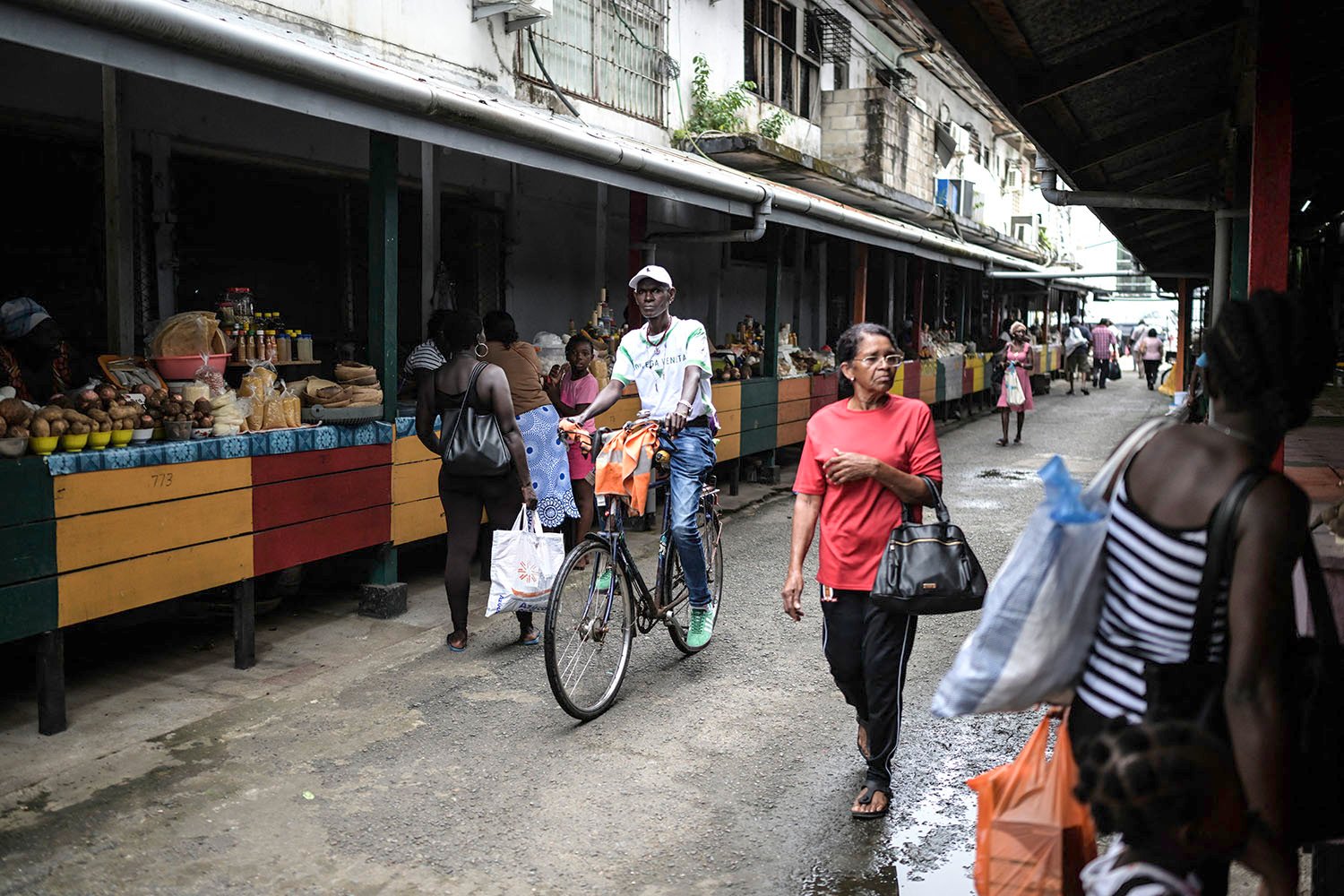
A man rides a bike down a street in front of a marketplace covered with an awning. Other passersby include several women with a shopping bags.
-
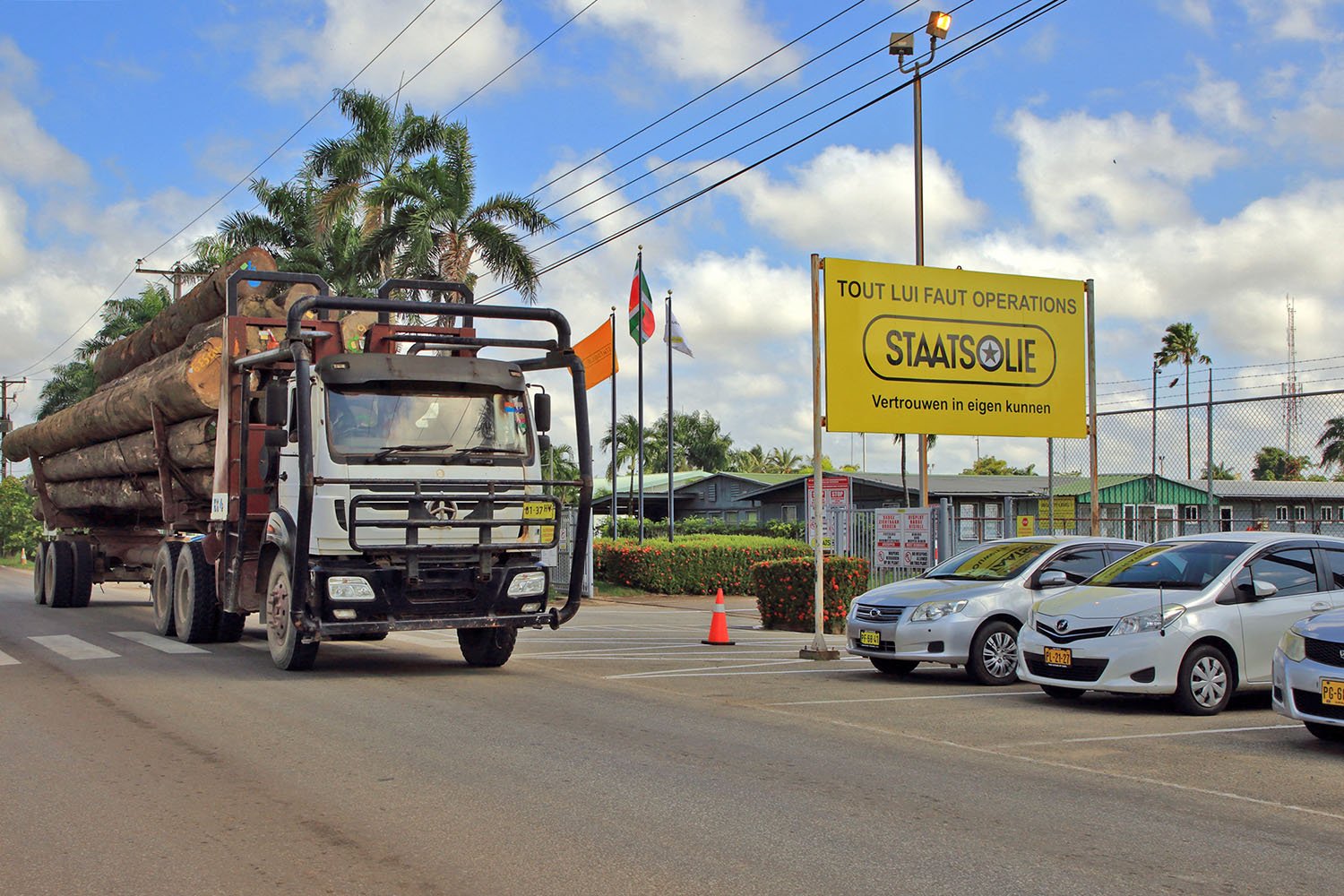
A truck carrying palm trees drives past a sign for Staatsolie. Power lines are above against a blue sky.
To hear Suriname’s leaders tell it, the oil project would allow the nation to uplift its citizens without harming the climate.
“The new dawn … means that Suriname is given a new chance for sustainable development,” said Chandrikapersad Santokhi, the country’s outgoing president, in his opening remarks at the conference. “The development of the oil and gas industry and carbon offsets go hand in hand in our country. We are not pursuing growth at any cost.”
Up until now, Suriname’s coveted “carbon-negative” status has been inextricably linked to its underdevelopment. Its slice of the Amazon sequesters more carbon than the country can emit only because its citizens by and large cannot afford the energy-intensive lifestyles that much of the world take for granted. The average resident earned less than $500 per month in 2024.
Now, Suriname’s leaders want to alleviate that poverty without becoming a net source of carbon. The plan is not just to make money and employ people, but also to use oil as a financing mechanism to build an economy that will someday become independent of fossil fuels, according to senior government officials who have served across the country’s recent administrations.
This means a host of new infrastructure projects and social welfare programs that check the boxes of sustainable development: Suriname will seed green industries such as ecotourism and climate-smart agriculture, build mangrove sea barriers and storm drain systems to stop flooding, and transition away from the use of imported bunker fuel and toward solar and hydropower.
But it also means allowing Total, the world’s sixth-largest oil company by market capitalization, to pump around 750 million new barrels of oil—more than will come from a massive oil development such as ConocoPhillips’s Willow project in Alaska. And that’s the bare minimum, assuming that no other multinationals strike crude and drill their own rigs.
“We have to diversify,” said Marciano Dasai, Suriname’s former environment minister. “We can say, ‘OK, we’re going to do the oil and gas,’ or we can say ‘OK, let’s do the oil and gas … to get us out of debt, and do the transformation to a green economy.’”
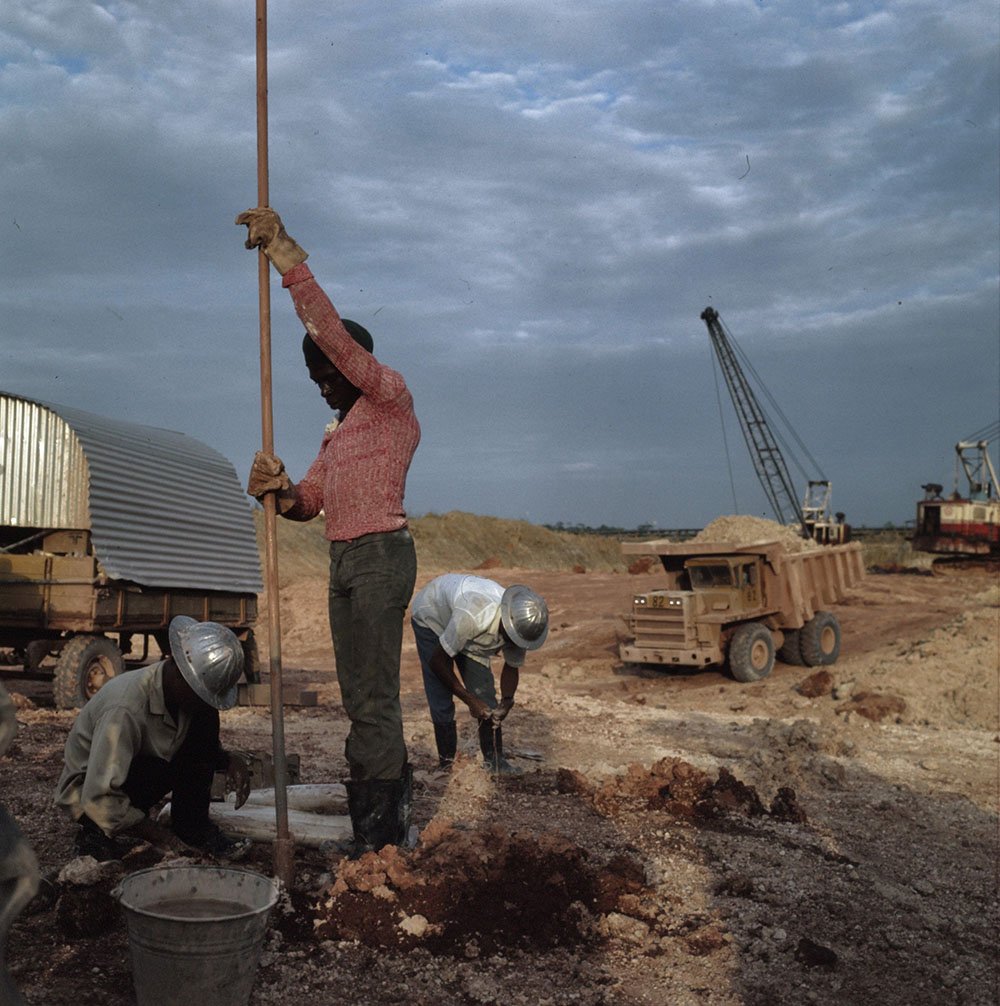
Suriname’s history reads like an argument against the idea that exploiting natural resources can bring about prosperity. When the country gained independence from the Netherlands in 1975, the U.S. aluminum firm Alcoa had been mining a mineral known as bauxite in the country for decades, but it offshored most of the profits. Since independence, the government has helped develop gold mines and two small onshore oil fields, but living standards are still low and inequality high.
In the years leading up to the coronavirus pandemic, Suriname sank into a debt spiral, the result of excessive household power subsidies and low prices for commodities such as gold that are its main source of export revenue. The country owed around half a billion dollars to China, $88 million to the Paris Club, and another half-billion to private bondholders that had lent money to the government to help it prop up public budgets. In 2020, the government defaulted on its sovereign debt, leading the International Monetary Fund to step in with strict curbs on government spending.
But as this debt crisis unfolded, seeming salvation was waiting offshore. In 2015, ExxonMobil made a major oil discovery off the coast of neighboring Guyana. Drilling studies soon found that the offshore ridge near Suriname contained billions of barrels worth of oil, much of it lightweight and easy to extract, plus vast stores of natural gas. A half-dozen firms started exploring in Suriname’s water, and in 2021, Total struck oil.
A discovery such as this often leads to disaster through the so-called resource curse: When poor countries become reliant on new fossil fuel revenue, it leaves them vulnerable to global price fluctuations, and their governments sometimes embezzle or misuse oil money rather than sharing it with citizens.
-
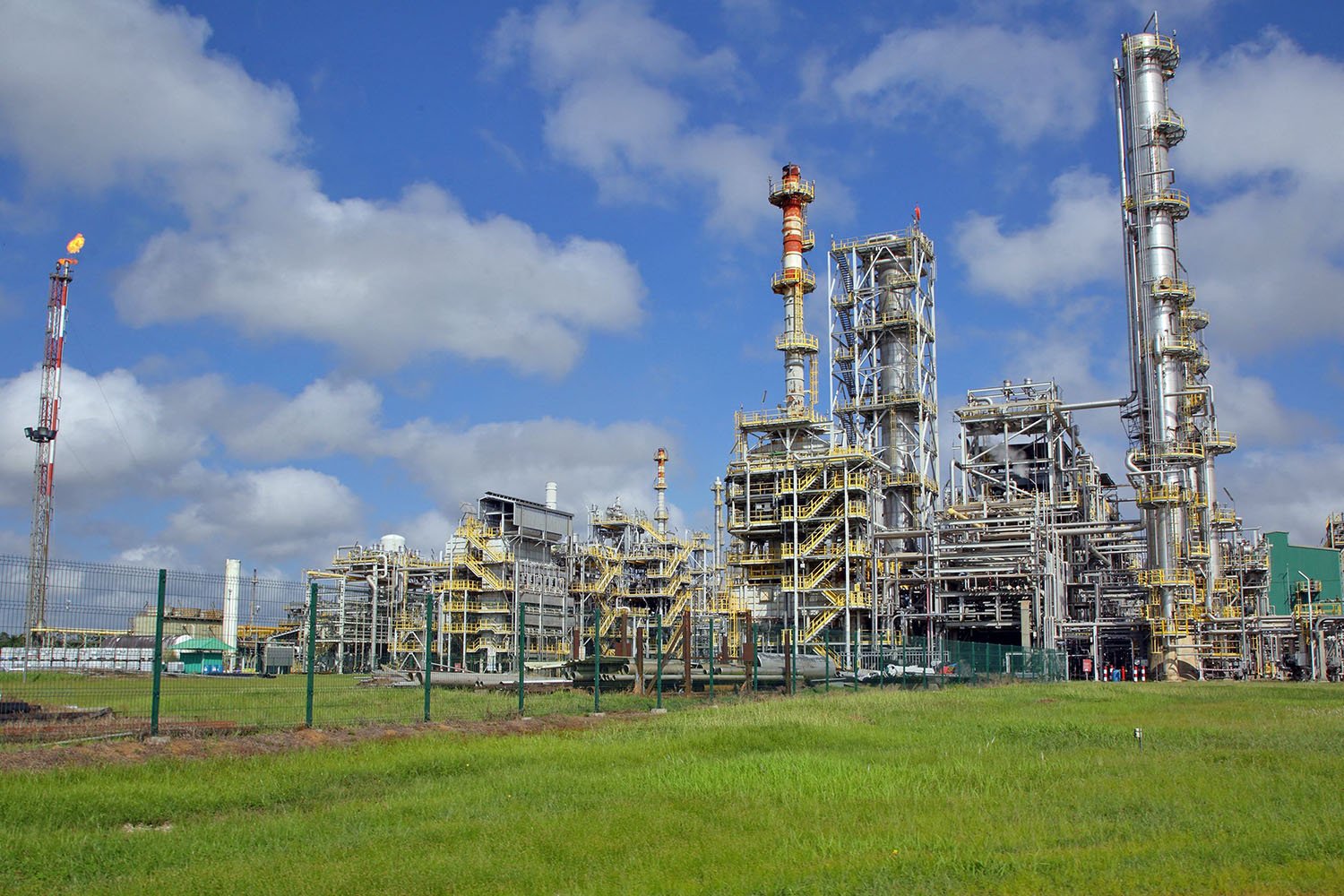
The towers of an oil refinery stretch up against a blue sky. The grass in the foreground is lush and green.
-
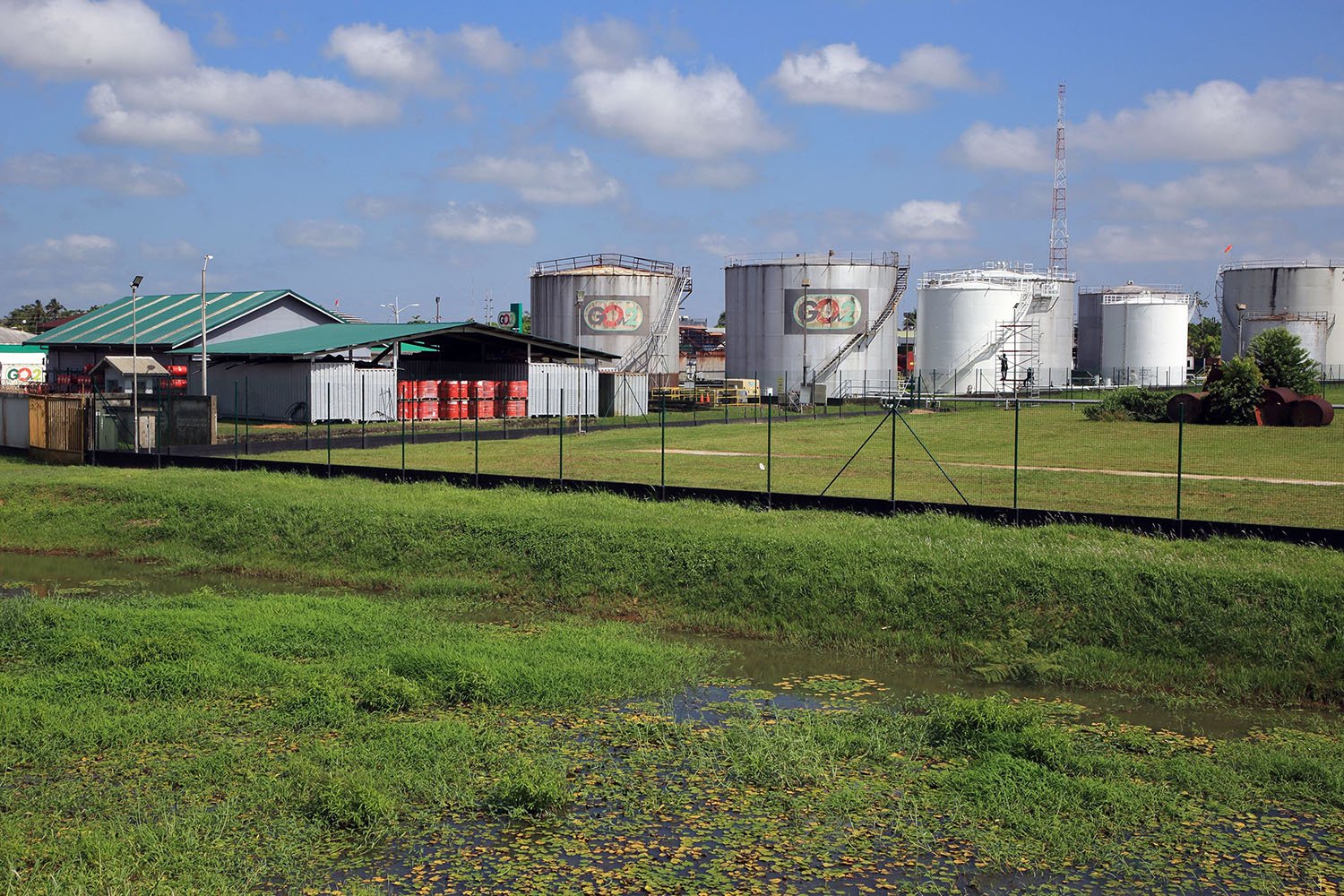
Green grass and fuel tanks sit on the horizon against a blue sky.
A companion phenomenon, known as Dutch disease, occurs when a country’s overwhelming focus on one new industry leads to a decline in the rest of its economy, as Suriname’s former colonizer experienced after a gas field discovery in the 20th century. Countries including Cameroon, Guyana, and South Sudan, to name a few, have developed oil projects over the decades that never delivered broad prosperity.
In theory, Suriname is in danger of falling into this trap. The country has a history of corruption, and until 2020, it was ruled by Dési Bouterse, a former soldier who staged a military coup in the 1980s and was later elected president. But it also had a secret weapon in its negotiations with Total. Because it had already developed a small onshore oil field in the 1980s, Suriname had a public oil company called Staatsolie, which operated relatively independently. Total’s revenue was two thousand times that of the state-owned company, and the latter had nowhere near the resources needed to drill for oil offshore. Still, its leaders had more fossil fuel expertise than those in most small countries.
Led by a mild-mannered engineer named Annand Jagesar, Staatsolie drove a hard bargain with Total: The smaller company insisted on a royalty rate of 6.25 percent, more than twice what Guyana was able to negotiate, as well as a 36 percent corporate income tax and a guarantee that Total would hire locals. Staatsolie also secured a $1.6 billion loan from development banks, which allowed it to take a 20 percent stake in the project. In all, Suriname will get up to 70 percent of the revenue from Total’s oil.
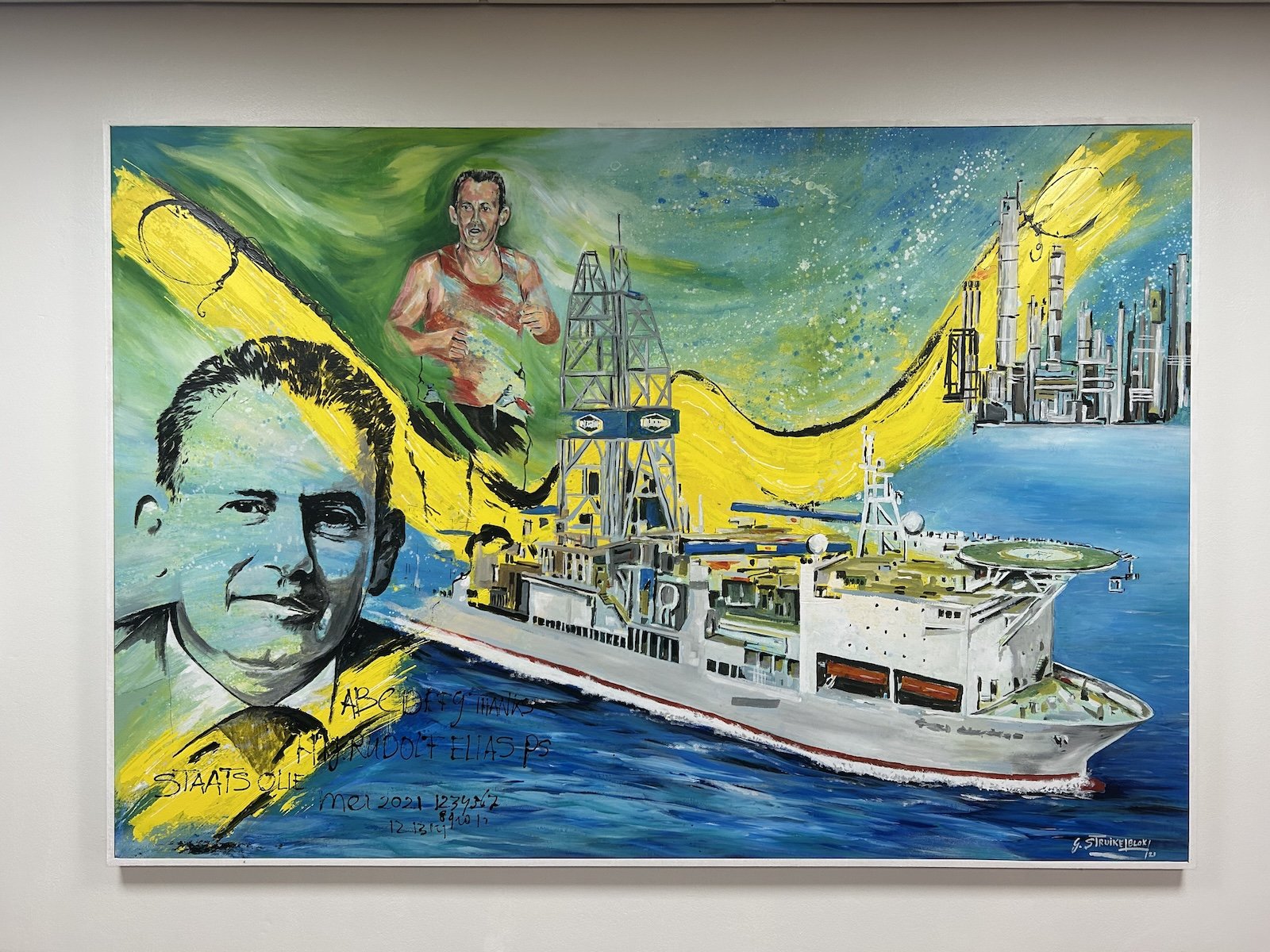
The talks were so tense that at one point, Total threatened to walk out. But Staatsolie held firm, and the larger company came back to the table.
Total “was not nice in the beginning, and we were not nice in the beginning, but I must tell you, this project is one of the best projects in the world,” Jagesar said at the conference in June. (The company did not respond to interview requests.)
Even before the Total deal was final, Suriname used the promise of future wealth to reverse its debt spiral. In 2023, the government restructured its Wall Street debt, and it passed legislation the following year to divert a chunk of oil revenue into a sovereign wealth fund modeled on Norway’s.
The turnaround was remarkable. Just a few years after defaulting on its debt, Suriname was on a path to being debt-free. Other major oil companies such as Chevron, Petronas, and Shell were staking out developments, encouraged by Total’s success.
Last October, Total made its final decision to proceed with the oil project, which the company called “GranMorgu.” The name was a pun—it is the name of a wide-mouthed fish that is native to Suriname’s offshore waters, but in the unofficial national language of Sranan Tongo, it means “New Dawn.” Given the scale of change that the oil project would bring to Suriname, the name seemed more than appropriate.
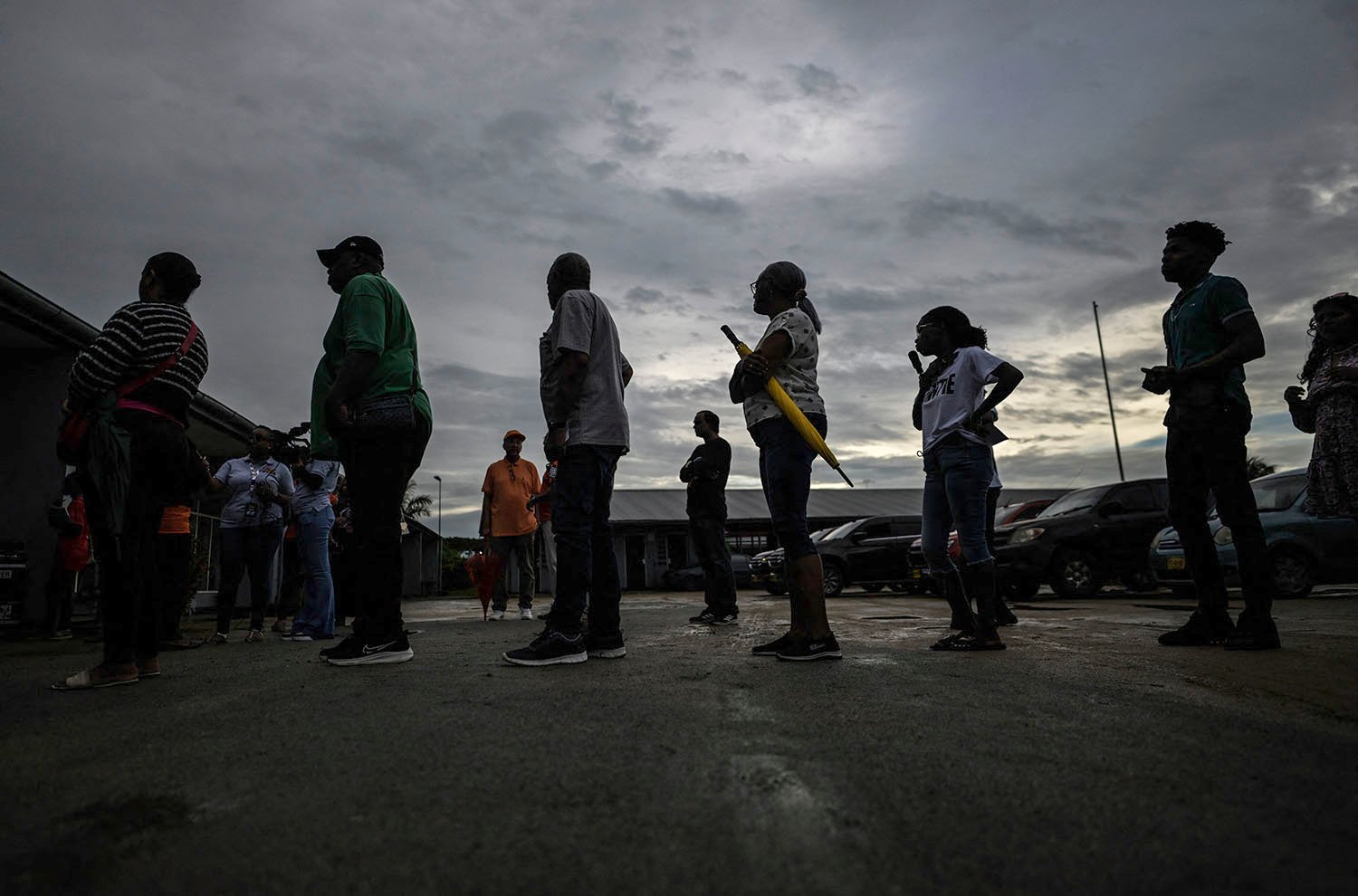
This oil project is good news for Suriname—its people are poised to get higher-paying jobs, more foreign business, and far better public services. But in the eyes of many of the world’s climate advocates, it’s a disaster, particularly at a moment when governments were supposed to be turning away from fossil fuels.
“As a sovereign state, we do have the right to exploit our resources in the way we see fit,” said Gina Griffith, the head of the Suriname chapter of Conservation International, a leading environmentalist nonprofit. “But it’s so contradictory.”
That Suriname has championed a new oil development is symptomatic of the impasse that plagues global climate policy. The 2015 Paris Agreement enshrined a principle known as “common but differentiated responsibilities”—in essence, the idea that rich countries, which got rich in part by producing the lion’s share of carbon emissions, must do more to fight climate change than poor countries. Wealthy nations have agreed in principle to not only reduce their own emissions but also to help protect poor countries against climate change and develop their green economies.
But rich countries have lagged on both tasks, particularly the responsibility to aid green development. They have failed to provide poor countries with anything like the money that would be necessary for “sustainable development,” or economic growth without fossil fuels.
The reason is simple: Such development is expensive, even more so than paying for infrastructure to protect against disasters. There have been isolated efforts by rich countries to create so-called just energy transition partnerships, or investment consortia that would help speed up decarbonization in certain countries, but these have largely failed to achieve deep carbon reductions—despite channeling huge amounts of money toward places such as South Africa ($8.5 billion), Vietnam ($15.5 billion), and Indonesia ($20 billion). The Colombian government is struggling to raise money for its own proposal to build a post-oil economy.
So countries fall back on the old models of development. This rush toward fossil fuels in places such as Nigeria or Senegal often elicits a lecture from wealthy countries that are decarbonizing, but the truth is that these countries don’t have much of a choice. U.S. President Donald Trump’s second administration, and in particular Energy Secretary of Chris Wright, have argued that this is good, that ending “energy poverty” through coal, oil, and gas development is ideal even if it harms the climate. The administration has cut foreign aid, withdrawn from the Paris climate accord, and slashed funding for the United Nations and other bodies, which will make financing green development harder for the rest of the world.
Suriname’s leaders argue that they have found a way to thread this needle. The country is building out a fossil fuel industry, with two big caveats. First, it is taking every possible step to reduce the emissions from its oil infrastructure while protecting its rainforest. Second, it is only developing oil as a means of building a low-carbon economy and raising the living standards of its citizens. Essentially, Surinamese officials say they are using oil revenue to do the development that rich countries won’t pay for.
“A lot of countries say, how can you do oil and gas, and then you have this forest? This is something that is contradictory,” said Dasai, the environmental minister. “We say that in this phase, especially now, the climate financing mechanisms are not working yet.” Given that the massive wealth transfer promised under the Paris Agreement has not happened, developing countries such as Suriname must both raise the living standards of their citizens and work to prevent harm to the global climate.
Total could be a good partner for such an effort, as perhaps the only supermajor oil company that has not retreated from its climate commitments. During the conference in June, Total executives pointed to plans for an offshore rig that will cut down on carbon emissions. The entire rig will be electric, and Total has agreed to reinject almost all natural gas that comes to the surface, flaring it only in emergencies. (Electricity use and gas flaring account for a large share of the emissions associated with getting oil out of the ground.) Suriname’s carbon ledger will technically remain negative overall.
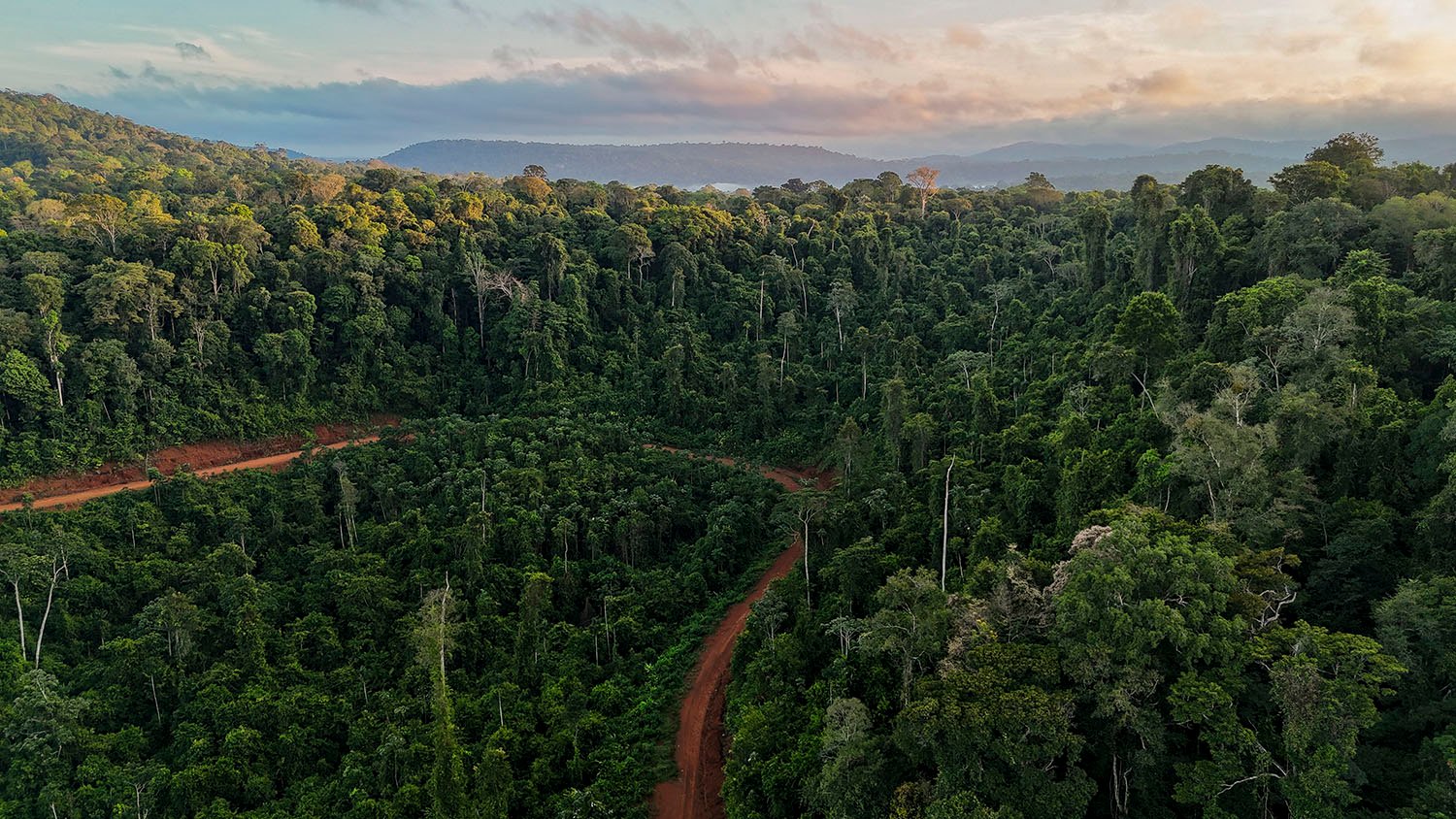
But the center of this mitigation effort will be the rainforest. Suriname’s relatively pristine Amazon jungle is the source of its carbon-negative status, but new mining and logging developments claim more of it each year. The country has lost about 1.5 percent of its forest cover since the turn of the century, according to one watchdog group. If left unchecked, deforestation could threaten the country’s carbon-negative status sometime in the next decade. So even as the country sells oil on the global market, it also wants to sell so-called carbon offsets, or monetized guarantees that the forest will stay intact. Many countries and companies purchase these credits on international exchanges to help counterbalance their own emissions.
The carbon offset industry is rife with fraud and negligence, and many offset projects around the world have fallen apart, but most experts anticipate that demand for these offsets will grow over the next few decades. For Suriname, rainforest credits could act as a companion product to barrels of oil, allowing foreign countries to buy both the fuel that they need and a counterweight to that fuel’s emissions. For Suriname, the credits could be a way to replace the financial benefits of destructive sectors such as mining and logging.
“The world has everything to gain from Suriname protecting its forests,” said John Goedschalk, a policy consultant who advises Suriname’s new president on climate finance. Total has offered to buy $50 million of Suriname’s potential carbon credits to appease its climate-conscious shareholders, and countries including Japan and Singapore have expressed interest in purchasing credits as well. (The country has not yet made a deal with any of these parties.)
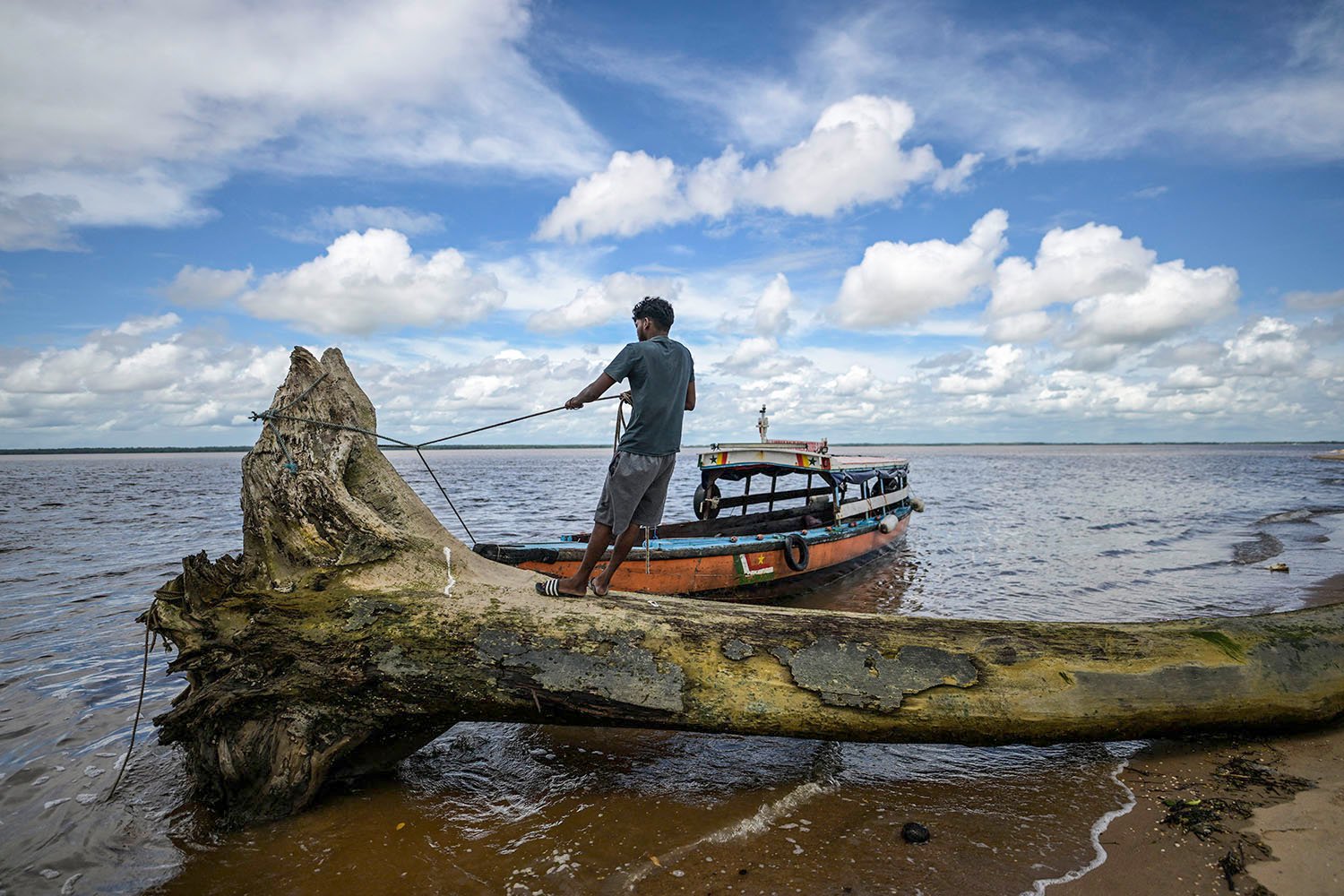
For attendees of the fifth annual Suriname Energy, Oil, and Gas Summit, the promise of low-emissions drilling and carbon credits were enough to allay the potential climate guilt that the rum cocktails didn’t assuage. Everyone present, from Santokhi and his ministers to the senior Total executives, insisted that developing an offshore oil project would not threaten Suriname’s carbon-negative status, and that it was consistent with a world where fossil fuel growth slows relative to the explosion in renewable energy—a world, in other words, where “transition” takes place at a comfortable pace for all parties.
However, this claim about carbon-negativity relies on imperfect arithmetic. Countries only tally the carbon emissions from within their borders. For Suriname, that means that it only has to count the emissions that come from pumping oil out of the ocean and loading it onto tankers for export; it does not have to worry about the emissions that come from burning the oil itself.
Just counting in-country emissions, it’s true that Suriname can build GranMorgu without becoming carbon-positive. But “Scope 3” emissions, from actually burning oil in trucks and planes, account for as much as 90 percent of the emissions produced by an oil company such as Total. The project will produce around 80 million barrels of oil per year, and burning all those barrels of oil will create more than 30 million tons of carbon dioxide—dozens of times more than Suriname’s rainforest can sequester. The project may not add much to Suriname’s own side of the carbon ledger, but the oil will still be burned somewhere.
Yet not all barrels of oil are created equal. As long as the world continues to use crude, it will find that crude from somewhere, and Suriname’s leaders argue that their oil is better for the climate. It is far cheaper and cleaner to extract than oil from places such as the Canadian tar sands, and GranMorgu will produce far less methane leakage than oil infrastructure in places such as Iraq. If global oil demand flattens or declines, Suriname could, in theory, outcompete and displace oil from other places, with marginal benefit for the climate.
In a scenario where demand falls fast due to rapid deployment of renewables and electric vehicles, Suriname may end up producing oil instead of rich countries rather than alongside them. Then, it could make a case for itself as a pragmatic climate leader, a country that is leveraging its resources while causing minimal new damage to the planet.
This was what gave the country such allure for Total, Chevron, and the other majors that staked out the conference. Even in 30 years, if oil prices fall and countries get picky about where they import from, GranMorgu and other projects will still be marketable. The European Union will impose a carbon tariff on oil imports by 2030, slapping an extra fee on dirtier barrels, and Total will be well-positioned to sell oil into the continent’s new climate-conscious market.
Of course, if demand doesn’t fall—if countries scuttle their climate policies and keep using more fossil fuels—then Suriname will be taking the same path as other developing countries before it, compromising the world’s future for the sake of its economic development. Even the bullish oil executives and market analysts in Paramaribo acknowledged that oil demand could not go up forever, but the world’s experts are divided on when this peak demand will arrive: The International Energy Agency expects a peak as early as 2029, but BP expects demand to continue rising well into the 2030s. OPEC no longer forecasts a peak at all.
The trajectory of oil demand is critical for the future of the planet, but Suriname’s leaders couldn’t wait around to see whether and when the curve starts to fall. With no other pathways toward development and the rich countries of the world still lagging, they had no choice but to start pumping.
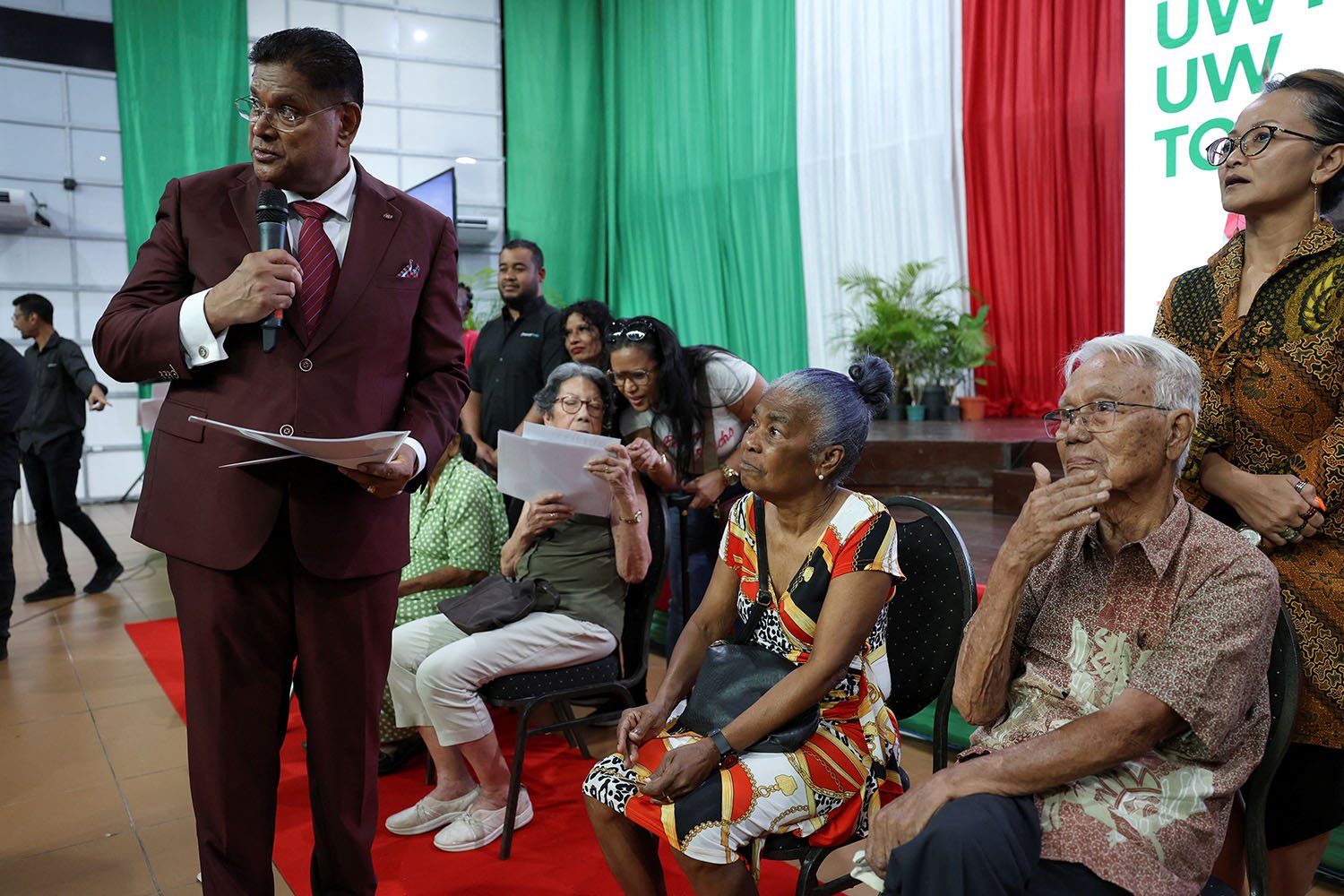
The other big uncertainty is whether Suriname can achieve the green development that its leaders have promised or get stuck in a fossil fuel rut.
Suriname’s leaders had only just begun to answer that question this year when the country held a national election in May. Santokhi faced voter ire during the campaign for cutting the fuel and power subsidies, which contributed to a cost of living crisis. In his reelection pitch, Santokhi unveiled an oil royalties program that promised every citizen a one-time dividend of at least $750, equivalent to about six weeks’ wages. This model is similar to the long-running Alaska Permanent Fund, which pays out regular oil dividends to state residents.
Voters still spurned Santokhi’s party, depriving him of a majority. Jennifer Geerlings-Simons, whose party won the most seats, formed a coalition in July and became the country’s first woman to serve as president. Geerlings-Simons is seen as level-headed, but her populist party had serious baggage—it was the party of the disgraced Bouterse, who died in exile after being convicted of assassinating political opponents and trafficking cocaine.
In Paramaribo, many Surinamese expressed skepticism about the new government. They said they trusted Staatsolie to regulate oil production but worried that elected officials would mismanage or embezzle new public revenue.
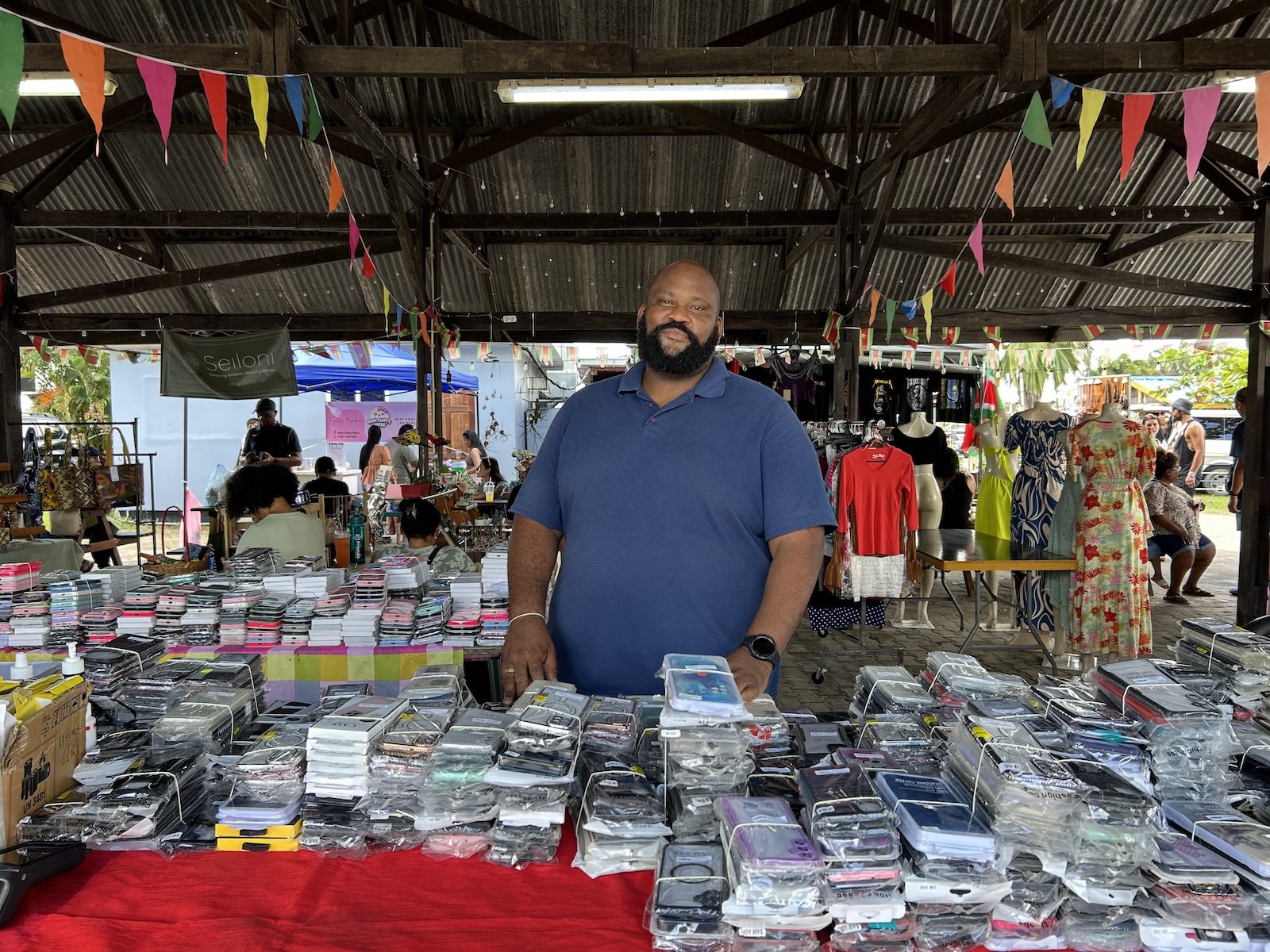
“If you look at the way the government has done things, there’s a lot of corruption,” said Jonathan Blackman, a vendor at a Javanese market in central Paramaribo. He said he wants the government to improve health care and road infrastructure in tangible ways rather than handing out cash. “They need to … make sure people have a better life,” he said. “Then they can keep the $750.” (Earlier this month, Geerlings-Simons’s administration paused the oil royalties program, saying it would instead invest future crude income in building a sustainable economy.)
There is no shortage of ways in which the government of Suriname could improve people’s lives. One of the most urgent investment needs is for projects that help Paramaribo adapt to the floods that clog the city almost every time it rains. The government could use oil money to expand drainage networks, extend sewer systems to fortify Paramaribo against rainstorms, and restore mangrove forests to protect outlying communities from sea-level rise and saltwater intrusion. It could also improve its roads and airports to stoke ecotourism, or build schools and hospitals to upskill workers and improve health outcomes. The government is already partnering with the Inter-American Development Bank to plan new investments in renewable energy, which will help the country end its reliance on the imported fuel oil that it burns for electricity. New revenue from Total’s crude could—somewhat paradoxically—help further those transition plans.
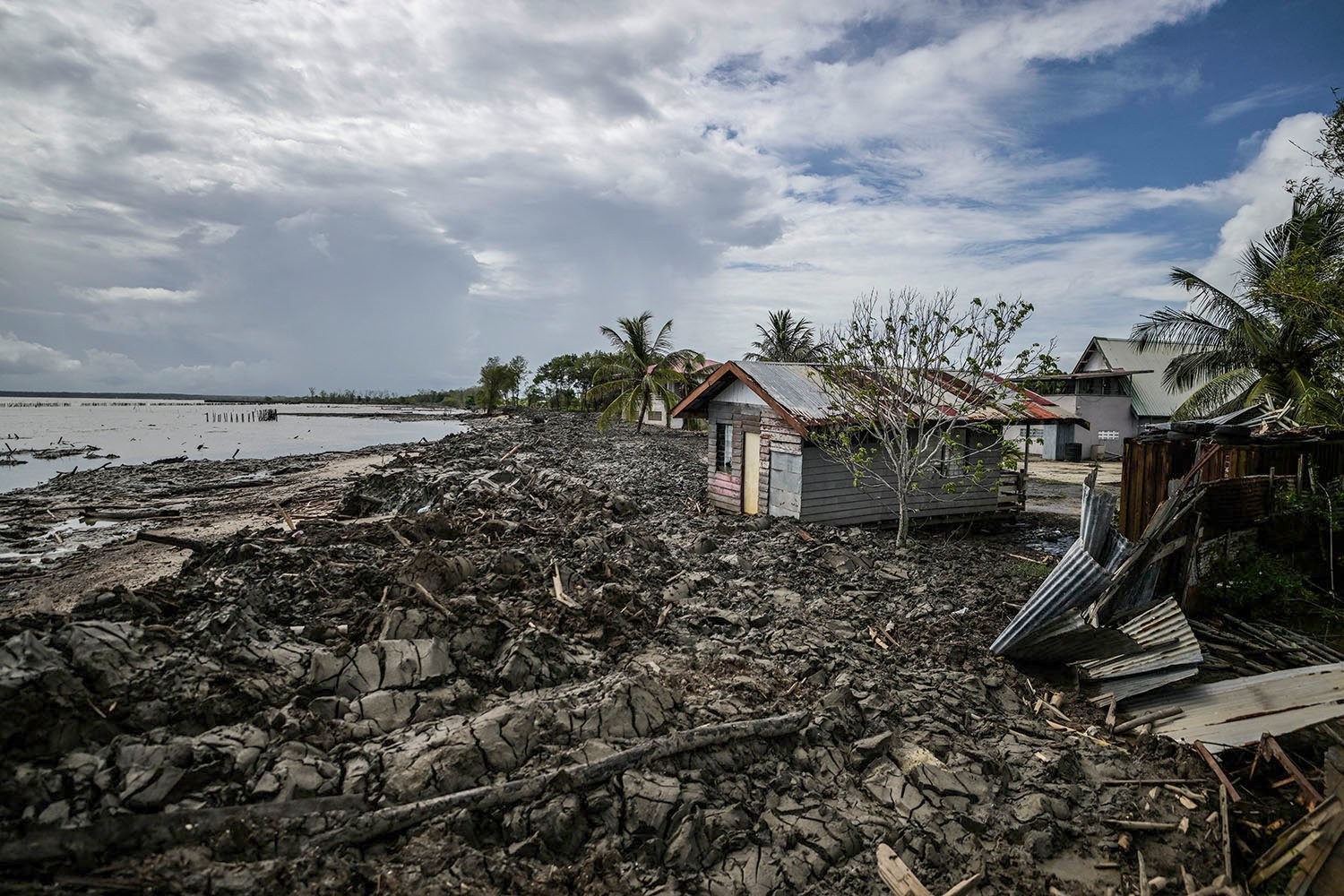
In the long term, the government will need to use oil profits to build an economy that plays to Suriname’s other strengths. Government leaders and climate experts in Suriname cite industries such as rainforest ecotourism and sustainable agriculture as potential growth areas. Yet again, marketing carbon credits will be a centerpiece of this strategy: If the country can become an ecotourism destination, develop a thriving farm sector, and generate tens of millions of dollars each year through the sale of rainforest offsets, then it may not need oil revenue by the middle of the century.
To arrive at this outcome would take careful planning, but it can be done. Santokhi had only just begun to confront this dilemma when he was ousted. In February, his administration released a “green development strategy,” naming several options for what “green development” might look like. But the government drafted no formal plan for how to spend oil money, held no public engagement on the subject, and hasn’t managed yet to sell a single rainforest carbon credit, despite international demand.
“There is no discussion being held, no national debate, about what we are going to do with our oil revenues,” said Griffith, of Conservation International, during the June conference. “We’ve been doing gold for the past 50 years and we’re still poor. I just think that we have been focusing too much only on the extractives and not diversifying and looking for other means of income.”
In her inaugural address, Geerlings-Simons said that her government has “the task of ensuring that the profits from the oil and gas sector improve the standard of living for every Surinamese.” Implicit in this promise was a recognition that it is not enough for the oil boom to improve Suriname’s dire finances. The country must also build a new economy with the consent and participation of its citizens. This will require ample public engagement, long-term planning, and transparency, none of which are hallmarks of the country’s recent past.
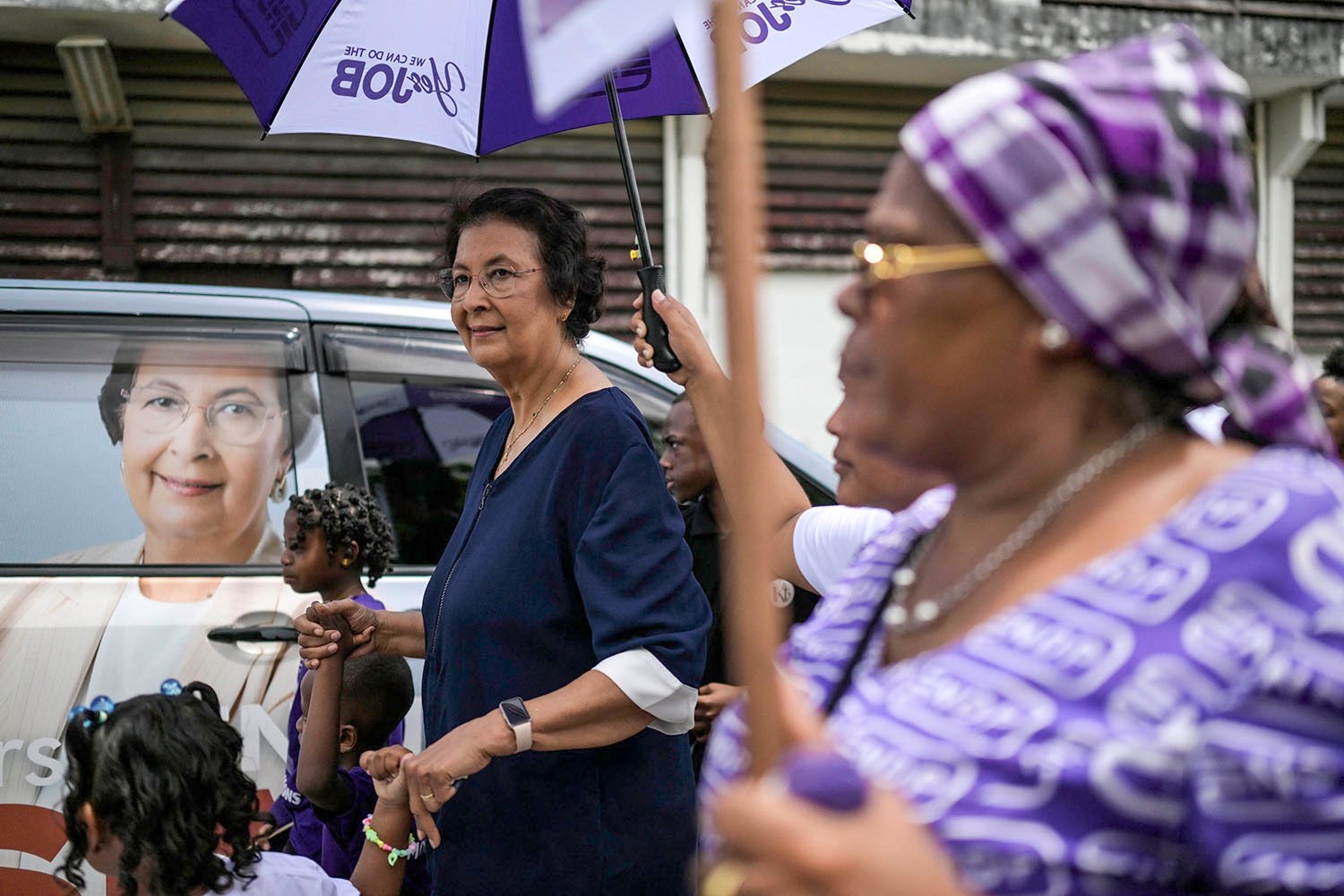
Suriname’s leaders have a cautious optimism that they can avoid the fate of other countries that have developed oil without planning for the energy transition and escape a legacy of corruption and instability. If Geerlings-Simons and her fellow leaders succeed, they will have done more than make the best of a bad hand—they will have gone a long way toward solving a problem that the rest of the world has failed to tackle. But if they fail, they will leave their own country dependent on the whims of the global oil market. They’ll also leave the world a little hotter and a little closer to catastrophe.
“If we do this right, then Suriname could become like a Valhalla,” said Goedschalk, the climate consultant, who will likely advise Geerlings-Simons on green development issues. “There’s so much to do, and a big part of what there is to do is to build an economy, because that was never done.”
The optimism is starting to catch on among some residents of Paramaribo. Down the street from the conference hotels, a computer technician named Jerry Goercharn runs Block 58, a bar that he’s named after the offshore section where Total found oil. Goercharn opened the bar a year ago amid the first news about the Total project. He filled the walls with maps of Suriname’s offshore oil and bought a model pumpjack for the entranceway, a sign of his optimism about the future.
“It’s definitely good, though it all depends on how the government will spend it,” he told me on an afternoon before the conference.
But it was too early to tell what Suriname’s future would look like, or to predict how the country would use its newfound wealth. Even as the sun set and dinner hour approached, the bar was still empty.
The post Suriname’s Coming Oil Boom appeared first on Foreign Policy.




